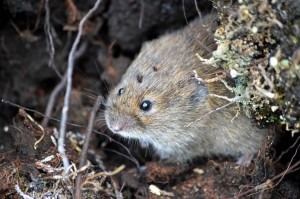Recently I touched upon the importance of otter dietary assessments and the wealth of useful information that can be ascertained through such targeted studies. Before any such surveys can be undertaken however it is first necessary to confirm the presence of otters in your target area. Otters, particularly those that inhabit riverine ecosystems, are largely nocturnal and thus rarely encountered by man. As such physical signs of otters are often used to indicate their presence in an area as opposed to visual sightings. Among these signs, tracks, anal jelly and scat, otherwise known as spraint are the most frequently encountered and thus of the most use. Other indicators such as prey remains and the presence of holts may be used but for the purpose of this post we will focus on the former three. [Read more...]
The identification of field and bank voles
 Voles (and other small rodents) comprise a vital piece of the puzzle that is the British ecosystem. Consumed by everything from Barn owls and Kestrels to Weasels and Wildcats, voles occupy a pivotal position in the food chain and their abundance has direct implications on the population dynamics of many predatory species. Particularly those of conservation concern such as Pine Marten and Wildcat. Vole populations often display strong cycles, increasing tenfold between high and low points, which when referencing the Field Vole occur every four years or so. This in turn has direct repercussions for predators and it has been shown that species such as Kestrels tend to fledge more young in years where voles are most numerous. Such population fluctuations are also the main driver behind the number of Short-Eared and Long-Eared Owls arriving in the UK each winter from the continent and likely have serious implications for many other species. [Read more...]
Voles (and other small rodents) comprise a vital piece of the puzzle that is the British ecosystem. Consumed by everything from Barn owls and Kestrels to Weasels and Wildcats, voles occupy a pivotal position in the food chain and their abundance has direct implications on the population dynamics of many predatory species. Particularly those of conservation concern such as Pine Marten and Wildcat. Vole populations often display strong cycles, increasing tenfold between high and low points, which when referencing the Field Vole occur every four years or so. This in turn has direct repercussions for predators and it has been shown that species such as Kestrels tend to fledge more young in years where voles are most numerous. Such population fluctuations are also the main driver behind the number of Short-Eared and Long-Eared Owls arriving in the UK each winter from the continent and likely have serious implications for many other species. [Read more...]
Thinking of becoming an ecologist?
Ecology is the branch of biology associated with relationships of organisms to one another and their physical surroundings. Ecologists study the connection between plants, animals and their environment.
To do this job you will need to identify species, be aware of endangered species and the current environmental legislation and issues, as well as carry out research and understand data. You’ll also need to manage projects and have great presentation and report writing skills. [Read more...]
Mammal Dropping Identification
Identifying mammal droppings in the UK
Mammals are usually extremely difficult to see, often the only signs of their presence are the droppings left. The presence of scat is a major indicator of the animals present
March is a good time to look for mammal faeces; new vegetation is yet to come through and many species are actively defending their territories. Carnivores often use their faeces to mark out their territories, so these are often left in noticeable places.
Identification is often based on smell and/or contents, using small twigs to inspect the remains or using rubber gloves to handle faeces. [Read more...]
Environmental DNA Testing for Great Crested Newts
Environmental DNA (eDNA) is a method to determine Great Crested Newt (GCN) presence or absence in ponds. In 2014, Natural England, approved the technique in which DNA is collected from water in which plants or animals live, rather than from the organism directly. In aquatic environments, great crested newt DNA is distributed though the dilution of urine, faeces, shed skin, hair, sperm and saliva. It can persist in the water for 7-21 days where it can be collected, typically at the same time that a Habitat Suitability Index (HSI) assessment of the water body is carried out. [Read more...]